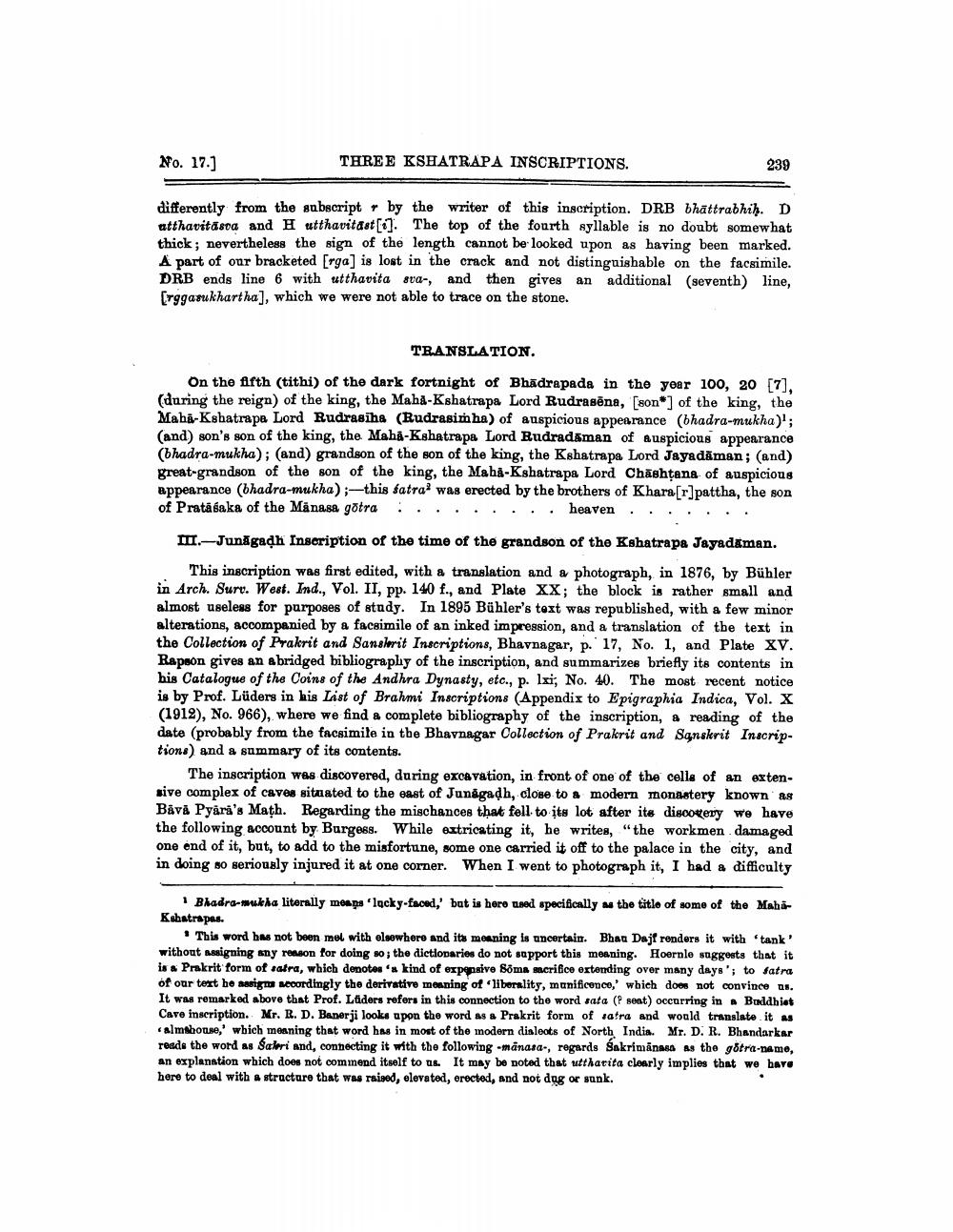________________
No. 17.)
THREE KSHATRAPA INSCRIPTIONS.
239
differently from the subscript by the writer of this inscription. DRB bhättrabhih. D atthavitāsta and Hutthavitast[]. The top of the fourth syllable is no doubt somewhat thick; nevertheless the sign of the length cannot be looked upon as having been marked. À part of our bracketed [rga] is lost in the crack and not distinguishable on the facsimile. DRB ends line 6 with utthavita sva-, and then gives an additional (seventh) line, (rggasukhartha], which we were not able to trace on the stone.
TRANSLATION.
On the fifth (tithi) of the dark fortnight of Bhadrapada in the year 100, 20 [7]. (during the reign) of the king, the Mahi-Kshatrapa Lord Rudragēna, (son*] of the king, the Maha-Kshatrapa Lord Rudrasiha (Rudrasim ha) of auspicious appearance (bhadra-mukha)"; (and) son's son of the king, the Maha-Kshatrapa Lord Rudradáman of Auspicious appearance (bhadra-mukha); (and) grandson of the son of the king, the Kshatrapa Lord Jayadıman; (and) great-grandson of the son of the king, the Maha-Kshatrapa Lord Chashtana of auspicious appearance (bhadra-mukha) ;-this fatra was erected by the brothers of Khara[r]pattha, the son of Pratåsaka of the Mänasa gotra ......... heaven ..... ..
II.-Junagadh Inscription of the time of the grandson of the Kshatrapa Jayadaman.
This inscription was first edited, with a translation and a photograph, in 1876, by Bühler in Arch. Suro. West. Ind., Vol. II, pp. 140 f., and Plate XX; the block is rather small and almost useless for purposes of study. In 1895 Bühler's text was republished, with a few minor alterations, accompanied by a facsimile of an inked impression, and a translation of the text in the Collection of Prakrit and Sanskrit Inscriptions, Bhavnagar, p. 17, No. 1, and Plate XV. Rapson gives an abridged bibliography of the inscription, and summarizes briefly its contents in his Catalogue of the Coins of the Andhra Dynasty, etc., p. lxi, No. 40. The most recent notice is by Prof. Lüders in his List of Brahmi Inscriptions (Appendix to Epigraphia Indica, Vol. X (1912), No. 966), where we find a complete bibliography of the inscription, a reading of the date (probably from the facsimile in the Bhavnagar Collection of Prakrit and Sanskrit Inscriptions) and a summary of its contents.
The inscription was discovered, during excavation, in front of one of the cells of an extensive complex of caves situated to the east of Junagadh, close to a modern monastery known as Båvá Pyara's Math. Regarding the mischances that fell to its lot after its discovery we have the following account by Burgess. While extricating it, he writes, “the workmen damaged one end of it, but, to add to the misfortune, some one carried it off to the palace in the city, and in doing so seriously injured it at one corner. When I went to photograph it, I had a difficulty
"Bhadra-mukha literally means 'locky-faced,' bat is here used specifically as the title of some of the Mahir Kshatra pas.
• This word has not been met with elsewhere and its meaning is uncertain. Bhau Dajf rendere it with "tank without Assigning any reason for doing so, the dictionaries do not support this meaning. Hoernle suggests that it is a Prakrit form of satra, which denotos kind of expensive Söma mcrifice extending over many days'; to fatra of our text he assigne accordingly the derivative meaning of liberality, munificenco,' which does not convince as. It was remarked above that Prof. Liders refers in this connection to the word sata (P seat) occurring in a Buddhist Cave inscription. Mr. R. D. Banerji looks upon the word as a Prakrit form of ratra and would translate it as «almshouse,' which meaning that word has in most of the modern disleots of North India. Mr. D. R. Bhandarkar roads the word as Salori and, connecting it with the following manasa., regards Sakriminass as the götra-name, an explanation which does not commend itself to us. It may be noted that uttharita clearly implies that we have here to deal with a structure that was raised, elevated, orected, and not dog or sunk.




